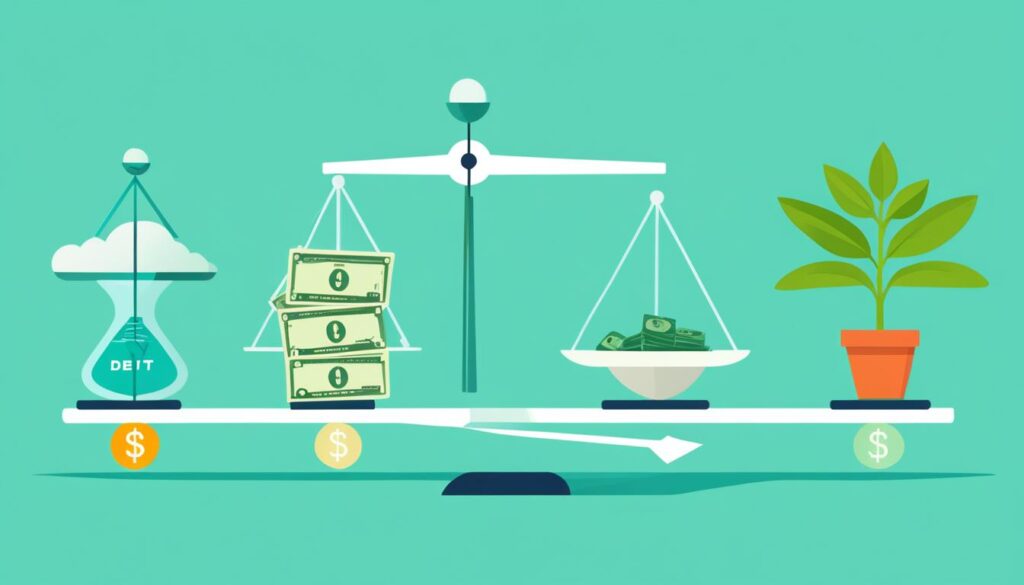Navigating the delicate equilibrium between balancing debt and retirement saving is a pivotal component of financial planning for debt and retirement. It is possible to craft a methodical approach to organize your finances and ensure your golden years are as golden as they should be. This guide will delve into practical retirement saving tips and debt management strategies that can adapt to any income level, offering a balanced path toward financial stability.
By creating a holistic budget and tracking your expenses meticulously, it becomes feasible to dedicate resources to reducing debt while simultaneously funneling money into your future. Forward-thinking steps, such as capitalizing on employer-matching retirement contributions, are akin to planting seeds that will bloom into a robust retirement portfolio. Moreover, preparing for rainy days with an emergency fund is an astute move, guarding against the need to incur high-interest debt when unexpected expenses arise.
Exploiting these strategies will increase your financial acumen, allowing you to tackle debts efficiently and build a retirement nest egg that can provide peace and security in your non-working years. This balance isn’t just an act of juggling; it’s a measured, methodical approach to ensuring every dollar you earn works effectively towards your present and future needs.
Key Takeaways
- Implementing a comprehensive budget to allocate funds adeptly for both debt repayment and retirement savings.
- Utilizing employer-matching programs to maximize retirement contributions effortlessly.
- Building an emergency fund to circumvent the accrual of high-interest debt during unplanned circumstances.
- Adopting a strategy to prioritize and pay down high-interest debt first to optimize financial outcomes.
- Planning incremental increases to retirement contributions to significantly impact long-term savings without immediate financial strain.
Understanding Your Financial Health for Debt and Retirement Planning
Embarking on effective debt and retirement planning begins by assessing your current fiscal status. In this era of multiple financial responsibilities, comprehending where your money goes every month is the key to achieving the delicate balance between living in the present and preparing for the future. This journey encompasses a meticulous budgeting for debt and retirement, focusing on the critical aspects of your financial life. Let’s delve into the steps to establish a robust monetary foundation that can support a lifestyle free from the clutches of overbearing debt, while fostering a nest egg for your golden years.
Conducting a Comprehensive Budget Review
First and foremost, it is essential to perform a thorough review of your budget. Detailing income against expenditures allows you to see the bigger picture—where you stand financially and how you can maneuver to align with your goals. This involves gathering bank statements, credit card records, and monthly bills to create a complete view of your spending habits. Such a review not only illuminates patterns of spending but also brings to light any financial leaks that could be sealed.
Establishing a Baseline for Spending and Saving
Upon a diligent examination of your accounts, establishing a baseline becomes crucial. This step will enable you to segregate the indispensable costs of living from discretionary expenditures. Establishing this benchmark is much more than listing your expenses; it represents a conscious decision to differentiate between what keeps you afloat and what can potentially anchor down your retirement savings.
Identifying Opportunities to Redirect Funds
With a clearer picture of your financial landscape, it’s time to pinpoint opportunities where funds can be redirected towards minimizing debt and maximizing retirement savings. Every eliminated luxury, such as that unused gym membership or the fifth streaming service subscription, paves the path for extra money that could be contributing to your debt repayment or retirement accounts. It is in these reshuffles and economizations that one can eke out substantial savings from a budget that once seemed stretched to its limits.
In conclusion, a thoughtful analysis and systematic approach to budgeting for debt and retirement can put you on the course to financial wellness, keeping the trepidation of debt at bay while accumulating a reassuring financial buffer for the twilight years.
Building a Safety Net: The Role of Emergency Funds
When it comes to debt reduction strategies, establishing an emergency fund is a fundamental step. This financial safeguard is crucial in avoiding unexpected debt instances that can derail even the most meticulous budget plans. By diverting a portion of your income into an emergency savings account, you are effectively insulating yourself from the need to rely on costly forms of credit when unexpected expenses occur.
Here is a snapshot of how an emergency fund fits into an overall plan for financial stability:
- Avoiding the drawbacks of high-interest borrowing options
- Creating a buffer between unexpected costs and your regular financial obligations
- Building peace of mind and reducing financial stress by having a ready reserve
Emergency funds serve as a linchpin in debt reduction strategies. The size of the fund can be tailored to individual circumstances, but a good rule of thumb is to aim for at least one month’s worth of income. This creates a robust barrier against unforeseen events that could otherwise push you into debt.
| Emergency Fund Goal | Benefits | Impact on Debt Reduction |
|---|---|---|
| 1 Month Income | Handles most minor emergencies | Prevents small unexpected expenses from accruing debt |
| 3-6 Months Expenses | Preparation for substantial emergencies or job loss | Provides a buffer to strategize repayments without new debt |
| 6+ Months Expenses | Comprehensive financial security | Ensures debt reduction efforts are uninterrupted during major financial setbacks |
As part of a strategic approach to personal finance, your emergency fund is more than a mere accumulation of cash; it is a testament to prudent planning and a commitment to avoiding unexpected debt. Initially, it may seem challenging to establish such a fund, but even modest, consistent contributions can grow over time to offer a significant financial cushion.
Maximizing Employer Retirement Contributions
For many American workers, navigating retirement saving options can feel complex, yet one of the most powerful tools available is harnessing the benefit of employer retirement contributions. Taking full advantage of these programs can significantly boost your retirement funds and set the stage for a more secure financial future.
Navigating Employer Match Opportunities
Employer match programs are a type of retirement saving option that can accelerate your journey toward a robust nest egg. To effectively tap into this resource, start by understanding the specifics of your employer’s plan. Know the percentage they match and the maximum contribution limits to align your own savings plan accordingly.

The Impact of Doubling Savings with Employer Match
The concept of employer matching is straightforward: for every dollar you contribute to your retirement plan, your employer contributes a matching sum up to a certain limit. This is virtually free money, and it is essential for maximizing retirement savings. By not contributing enough to get the full match, you’re leaving money on the table that could compound over time.
Increasing Contributions Over Time for Long-Term Gain
Growth in retirement funds is not just about what you contribute today; it’s also about how those contributions increase over time. It’s advisable to ratchet up your contributions incrementally—such as with every salary increase—to benefit from the compound growth provided by employer retirement contributions. This disciplined approach can have a monumental impact on your retirement readiness.
| Year | Your Annual Contribution | Employer Match | Total Contribution |
|---|---|---|---|
| 1 | $2,000 | $2,000 | $4,000 |
| 2 | $2,200 | $2,200 | $4,400 |
| 3 | $2,400 | $2,400 | $4,800 |
| 4 | $2,600 | $2,600 | $5,200 |
| 5 | $2,800 | $2,800 | $5,600 |
As you continue to explore employer retirement contributions and other retirement saving options, remember that sacrificing small comforts today for the sake of increasing your retirement contributions can have a profound impact on your financial security in the future. Employers who offer retirement savings match programs provide a significant opportunity, but it is up to the individual to ensure they’re maximizing this benefit to its fullest potential.
Strategic Debt Reduction: Prioritizing High-Interest Debts
In the quest for financial freedom, particularly as retirement approaches, individuals must confront their outstanding debts head-on. Debt consolidation for retirement saving has gained traction as a means to streamline finances and reduce overall interest burden. A tactic critical to this method involves high-interest debt prioritization, ensuring that the most costly debts are cleared first to reduce interest accumulation that eats away at potential savings. Here are some actionable steps to consider:
- Review your debts and order them by interest rate, from highest to lowest.
- Focus on allocating extra payments to the debt with the highest interest rate while maintaining minimum payments on other debts.
- Once the highest-interest debt is fully paid off, redirect those funds to the next one on your list, creating a powerful snowball effect.
- Consider debt consolidation loans only if the interest rate is lower than your current debts, being cautious of any hidden fees.
- Refrain from incurring new high-interest debt by using budgeting tools and expense tracking.
Moreover, any savings recovered from these paid-off debts can be channeled directly into your retirement accounts, further fortifying your nest egg. The table below illustrates how prioritizing high-interest debt can make a significant impact on your financial landscape.

| Debt Type | Interest Rate | Minimum Monthly Payment | Additional Monthly Payment | Time to Payoff | Total Interest Saved |
|---|---|---|---|---|---|
| Credit Card A | 18.99% | $120 | $180 | 2 years | $1,200 |
| Credit Card B | 15.99% | $90 | $0 (until A is paid) | 4 years | $600 |
| Personal Loan | 9.5% | $200 | $0 (until A and B are paid) | 5 years | $500 |
By aggressively tackling higher-interest debts first, you’re able to cut down on the cumulative interest paid over time, thus enabling more funds to be saved or invested towards retirement. This approach not only simplifies your debt portfolio but also accelerates your progress towards sound financial health.
The Balancing Act: Balancing Debt and Retirement Saving
Finding equilibrium between balancing debt and retirement saving is not a one-time task but an ongoing process. It’s about making conscious decisions every day that contribute to a stable financial future. Effective financial planning for debt and retirement isn’t just about numbers; it’s about blending forethought with action and adapting as life unfolds.
Assessing Debt Versus Retirement Saving Needs
Beginning with an honest evaluation of one’s current debt levels and comparing them to retirement aspirations forms a foundation for balanced financial planning. It’s essential to understand the impact of debt repayment timelines on retirement goals and vice versa. Depending on life stage, focusing on aggressive debt payment may take precedence, whereas in other cases, it might be prudent to ramp up retirement contributions.
Small Steps That Lead to Substantial Growth Over Time
Progress in financial health, particularly when it comes to retirement saving tips, emphasizes the power of small actions. A modest increase in retirement contributions, even 1% annually, can significantly enlarge one’s nest egg over time. These adjustments might seem insignificant in isolation, but compound interest magnifies their effect, proving that patience and persistence go hand in hand.
When You Can Save More for Retirement Even with Debt
Maintaining a commitment to balancing debt and retirement saving often requires prioritizing long-term benefits over short-term gains. By identifying and capitalizing on opportunities to save more for retirement—such as during a salary increase or after paying off a specific debt—one can deliberately work towards bolstering their retirement savings irrespective of persistent debt challenges.
Conclusion
In the intricate dance of financial planning for debt and retirement, the key to maintaining equilibrium lies in a thoughtful and proactive approach. It necessitates a blend of astute budgeting, an aggressive stance against high-interest debts, the security of established emergency funds, and the smart use of employer contributions. Each component is a critical step on the journey toward a secure and prosperous retirement.
Personal circumstances shape the financial strategies we adopt. Debt and retirement planning isn’t a one-size-fits-all solution; rather, it’s a personalized blueprint that requires constant reassessment and adaptation. While existing debts may seem overwhelming, prioritizing them need not derail your retirement saving objectives. With retirement saving tips and a steady focus on incremental financial enhancements, future goals become attainable, setting the stage for a stable financial landscape.
Indeed, securing your financial future is a formidable task, but with dedication to retirement saving tips and a strategic outlook on debt and retirement planning, the piece-by-piece construction of your financial foundation will ensure resilience against fiscal uncertainties. It’s not merely about managing debts or squirreling away retirement funds—it’s about creating harmony between the two. By aligning today’s actions with tomorrow’s aspirations, the path unfolds towards a balanced and fulfilling retirement.
How can paying off my mortgage impact my overall retirement saving strategy?
Paying off mortgage wisely strategy can significantly impact your overall retirement saving. By eliminating a major monthly expense, you can free up more funds to contribute to your retirement accounts. You’ll also have the option to downsize your home and use the extra equity to bolster your savings.
FAQ
How can I balance paying off debt with saving for retirement?
To balance paying off debt and saving for retirement, create a comprehensive budget that allocates funds for both objectives. Prioritize high-interest debts to minimize interest expenses, and make sure to contribute to retirement savings, especially if your employer offers a matching contribution.
What should I focus on first: debt reduction or retirement saving?
It’s important to focus on both simultaneously, but prioritize high-interest debt to reduce costly interest payments. Once high-interest debts are under control, you can increase retirement savings. However, even with debt, contribute enough to your retirement to take full advantage of employer-matched funds, as this is essentially free money.
How do I conduct a comprehensive budget review for debt and retirement planning?
Begin by gathering all your financial statements, including bills, bank statements, and credit card transactions. Identify your income, mandatory expenses, and any discretionary spending. From there, you can make informed decisions about where to cut expenses and how toredirect funds toward debt reduction and retirement saving.
How much should I contribute to an emergency fund?
Aim to initially save at least one month’s worth of income in your emergency fund. Over time, try to build that up to three to six months’ worth of living expenses. This will help you manage unexpected costs without increasing your debt, which is crucial for maintaining financial stability while you pay off debt and save for retirement.
What are the benefits of maximizing employer retirement contributions?
Maximizing employer retirement contributions can significantly increase your retirement savings without extra effort on your part. Employer match programs offer free money towards your retirement, and by not taking full advantage, you’re essentially leaving money on the table. Incrementally increasing your contributions to meet or exceed your employer’s match can substantially benefit your long-term financial health.
Why is it important to prioritize high-interest debts?
High-interest debts, such as those on credit cards, can compound quickly and overshadow any returns you might gain from investments. By prioritizing these debts, you can reduce the overall amount of interest you pay, freeing up more funds for retirement savings and other financial goals.
When can I afford to save more for retirement while still having debt?
Once you have your high-interest debt under control and are steadily paying it down, reassess your budget to identify any surplus that can be redirected toward retirement savings. As your debt decreases, you should aim to incrementally increase your retirement contributions, especially if you are behind on your retirement goals.
How do emergency funds contribute to debt and retirement planning?
Emergency funds act as a financial cushion that can help you cover unexpected expenses without resorting to high-interest borrowing options. By avoiding new debt, you can keep your financial plan on track and continue dedicating resources to both debt reduction and retirement saving without setbacks.
Are there any strategies for minimizing debt while maximizing retirement savings?
Yes, strategies include structuring your budget to manage both priorities, reducing discretionary spending, and applying any additional income—like bonuses or tax refunds—toward debt or retirement savings. Consider debt consolidation to lower interest rates and explore various retirement saving options that offer tax advantages to optimize your savings efforts.
What are small steps that lead to substantial growth over time for retirement savings?
Small steps include starting with a manageable contribution to your retirement accounts and increasing it annually or whenever you get a raise. Automating your savings so that money goes directly into your retirement account can also ensure consistent growth over time, leveraging the power of compound interest.

